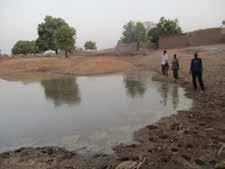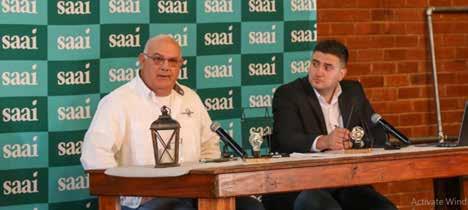
6 minute read
Fish farming tackles malnutrition in Uganda
Fish project tackles malnutrition in Uganda
In Ugandan lakes, three highly nutritious, fingersized fishes, known locally as ‘muziri’, ‘ragoogi’ and ‘mukene’ dominate fish catches. However, their nutritional – and economic – benefits are not being realised because high post-harvest losses, caused by improper handling and processing techniques, impact quality and consumer appeal.
Advertisement
The NutriFish project is making the most out of these fish through the development of five nutrient-packed, fish-enriched food products, including a cooking sauce and maize meal for mothers and babies. The fish sauce, which is used in place of beans as a source of protein, cooks in just 10 minutes compared to 1-3 hours for beans. Local families are therefore able to cut down on their energy requirements and reduce their environmental impacts whilst meeting their nutritional needs. The project has also engaged street vendors who make chapatti, normally served with beans, to encourage them to sell their flatbread with the fish-enriched sauce to increase uptake.
It has also tackled Anaemia, a deficiency, caused by low iron consumption, that is commonplace in Uganda – where malnutrition in general is rife, and represents a serious challenge to human health and economic development.
Anaemia affects women of reproductive age and children under five years in particular because these groups struggle to access food of animal origin, especially fish, due to unavailability and expense. Rich in protein and other nutrients essential for good health, fish is considered a ‘superfood’ and optimal for child development.
To help communities reduce their post-harvest losses and access a more reliable supply of processed fish products, NutriFish has introduced solar tent drying technology as an alternative to traditional open-air sun-drying. The tent drying process is faster and cleaner than traditional methods, whilst also being sustainable, and is enhancing the livelihoods of women who constitute the majority of local fish processers. Processed fish quality has improved, increasing the shelf life from 6 to 8 weeks, to nearly 5 months, and has doubled incomes for the women processers.
To further improve the sustainability of small fish processing businesses, the electronic Catch Assessment Survey (eCAS) assessment survey, a simple app, has been developed by the project. Fishers can use this on their mobile phones to collect and transmit catch data on a daily basis. The information provided by the fishers informs the project when fish stocks are low. This data is passed on to local policymakers and feeds into recommendations that help avoid overfishing and ensure sustainable management of the fish stocks.
Betty Mercy Timbe from Ntoroko landing site on Lake Albert never ate small fish whilst growing up: “I thought they were too small to eat,” she explains. But after attending a training session with the project to learn about the nutritional benefits of fish, she tasted fried mukene for the first time - “It was very delicious,” she enthuses. Betty has since become a project ‘champion’, taking the information she learnt back to her community and encouraging more people to eat small fish by offering them as snacks at her local bar. She has also been able to mobilise 11 women into forming a fishing group. Previously, the women had to buy fish from other fishers - who would determine who got what number of fish – but now, they own seven boats themselves and since coming together, have been able to enhance their earnings to an estimated US$1,200 per month from various fish-trading activities. The women are using the income to meet their family needs and expand their businesses.

Fish Farming in Mali
Part of the Long-Term Solution to Militancy and Instability
By Kate Schecter, CEO, World Neighbors
Militants recently struck Mali’s main military base outside the capital of Barmako. This is one of the many attacks by militants and “hooligans” the country has endured for years. While military force will play a role in stabilizing the country and laying the groundwork for better lives for its citizens, it’s not the entire story. The only long-term solution to poverty and violence— much of it committed by young men seeking a source of income—is economic development.
This includes the kind of low-cost, highimpact community-based programs like those in Sourountouna. Villagers there are taking numerous steps to increase their incomes. An important one is cooperative fishponds. The village cooperative is raising, harvesting and selling tilapia and catfish. In one recent sale, members sold fish to members of the cooperative and others in the village for a total of $470.00. Of this, $393.00 was gross profit. That profit and others are deposited in a community-managed savings and credit fund to meet village and individual needs. This includes a pump to supply water for the village; a blackboard and other materials for womens’ literacy training; and contributions to the school’s management committee. Individuals can also take out loans at very low or no interest to invest in agricultural implements, home based businesses and other income-producing ventures.

Capital accumulation and investment in profitable businesses that meet basic needs catalyzes economic and social development. It holds longterm promise to reduce poverty, instability and the fuel for both militant and state violence. To speak with World Neighbors, the development organization implementing the fishpond and other programs, please contact me at 202-554-5796.
Saai launches landclaim.org
Land claims can cripple a farm. Thousands of land deals, financing applications and plans to develop or expand have been bedevilled by land claims, and this has cost South Africa inestimable jobs and rural development. That is why the family farming network Saai today launched the most extensive digital land claims database. This web page enables users to determine their land claim status themselves in about 20 seconds.
The database consists of all Government Gazettes since 1998 in which anything has been published about land claims or alleged land claims, as prescribed by section 11(1) of the Land Rights Act (No. 22 of 1994). Apart from giving users access to a database of land claims that have already been gazetted, it can also send a request to the relevant provincial land claims commissioner to find out if there is a claim on a user’s land which has not yet been published. It also stores all searches and information so that we can notify users immediately if a claim arises in the future.
“This database is part of a comprehensive strategy of many years to enforce transparency and order regarding the land claims process. Saai makes this database available to the general public because it is in their best interest,” said Francois Rossouw, CEO of Saai. Until today, the department has never provided a complete list of all the claims that have been submitted. Therefore, on 4 May 2021 Saai sent a PAIA request to the Department of Agriculture, Land Reform and Rural Development (DALRRD), requesting them to provide Saai with copies of every land claim published in the government gazette from 1998 to 2021.
According to the DALRRD, it would be a “laborious” task to comply with the request, and they simply ignored further writings. On 21 February 2022, Saai received a court order obliging the DALRRD to provide the information to Saai. However, the department has not yet complied with the court order. Therefore, Saai is

Dr. Theo de Jager en Francois Rossouw
applying for contempt of court by Minister Thoko Didiza.
“The uncertainty and crippling implications that a chaotic land claims office has on agriculture are unaffordable. As in many other sectors of the economy, there is no other alternative for South Africa than enforcing better service delivery and management through the courts,” said Dr Theo de Jager, CEO of Saai.
The platform is available free of charge to members of the public at https://bit.ly/landclaim_ org. The next phase of the platform will also feature labour tenant claims.



